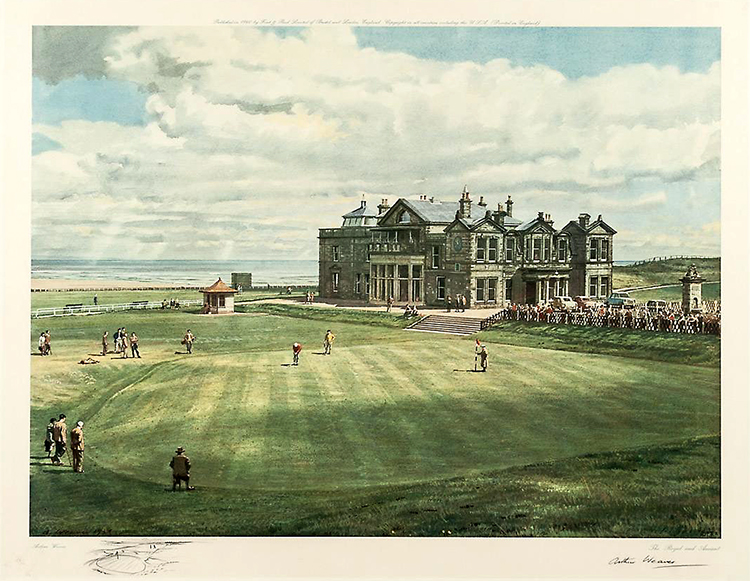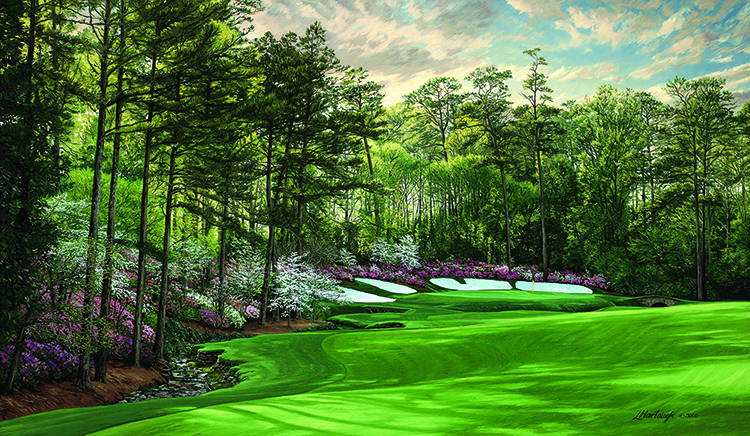
By John Fischer III
The purpose of this article is not to tell the reader what golf art to purchase or how to rate golf art. It is, rather, to let the reader know the more technical aspects of what he is looking at. The article is also limited to paintings and prints, art which can be hung on the wall, and not ceramics, statuary or paperweights.
(Links to brief articles on individual golf-themed works and artists may be found at the bottom of this article.)
With a painting or an original drawing, it is fairly simple to see what you are getting, unless the item is a forged copy. Generally, the collector can decide on what to acquire by a simple set of decisions – does the collector like the subject matter, is the painting well executed and is the artist known, the latter question being perhaps of no consequence, unless the artist is well known bestowing a value by virtue of the artist’s name alone.
Most golf art is in the form of what is loosely called a “print,” which is the focus of this article. It is a good idea to know the terms used to describe prints so the collector knows what he is getting; the lexicon is similar to that used by book collectors and having a working knowledge of it will help in making informed collecting decisions.
Types of Prints
There are four basic types of printing methods: the relief print, the intaglio print, the lithograph, and the serigraph sometimes also referred to as a silk screen print.
The Relief Print
In making a relief print, the artist carves out the area not to be printed from the end grain of a block of wood or from linoleum blocks or similar material. Ink is run over the raised area and paper is pressed against the ink producing the print.
The Intaglio Print
With the intaglio print, the process is reversed. The artist carves out the area which is to be printed, the ink is spread over the surface and the ink is wiped off the raised area. The paper is placed over the surface, and is pressed against the surface with enough force to push the paper onto the ink.
There are various types of intaglio prints. The oldest is the engraving where a line is cut into a metal plate with a sharp tool known as a burin. The engraver can produce intricate lines giving the feeling of depth and texture. The pieces of metal known as burrs carved out of the plates are wiped off before the ink is applied.
A variation on the engraving is the drypoint, where the burrs are not cleaned off the plate. The carved grooves are filled with ink but the burrs, still clinging to the edges of the groove, are also inked leaving a softer furry line. The raised burrs eventually wear down from the pressure of the press.
Most collectors value the first in the series of drypoint prints because of the richness of the lines. Placed side by side, the early drypoint prints and the later in a long run can be clearly differentiated.
An engraving is made by coating a metal plate with a waxy substance known as a “ground,” and the engraver draws an image in the wax exposing the metal plate. The plate is then dipped in an acid bath which burns lines in the plate. The plate is then inked, the ink wiped off the surface leaving the ink in the grooves made by the acid.
The aquatint is an extension of an engraving. The engraving is made and then portions of the plate to be modified are coated with a porous wax which leaves a grain when placed in the acid bath. Areas not to be changed are coated with ground. This process can be repeated until the artist has achieved the intended result with perhaps nine to 12 separate acid baths. Using the porous wax as the ground, the engraver can produce very subtle toning.
With the mezzotint, the artist roughs the surface of the plate creating burrs and then reduces the burrs to create shading and tones. No lines are visible. The burrs are so close together that if printed without removing any burrs, a solid black would be produced.
Because the burrs are raised on the plate, successive impressions wear the burrs down. A mezzotint plate may produce 100 prints of which 50 would be of high quality and the balance begin to lack detail.
The mezzotint is the most difficult to produce but also results in the finest print. One art critic describes a mezzotint image as seemingly emerging from the black background.
Many of the early golf prints were copies of paintings. For instance, the famous mezzotints of James Balfour (by J. Jones in 1796) and John Gray (by G. Dawe in 1806) were “copied” from much larger oil portraits by Sir Henry Raeburn. “Copied” is not really the correct word: to make the mezzotint, the artist reproduced the painting in a smaller size and in reverse on the plate. The mezzotint is as much a work of art as the painting from which it was taken.
The same holds true for the Charles Wegstaffe’s engraving from Charles Lees’ great painting “The Golfers.” Each individual in the match and in the accompanying gallery is really a separate portrait. Imagine, then, engraving this in a smaller size and backwards on a copper plate.
The Lithographic Print
The lithograph printingsurface is flat as opposed to the relief print or the intaglio print which rely on inked raised surfaces or grooves to produce the print. On a true lithograph, the printing surface is stone rather than a metal plate.
The drawing is made with a grease pencil to which grease ink will attach. The surface is then covered with water to which the ink does not adhere. The image is then “fixed” with a chemical solution.
The modern lithograph uses a series of very small “dots” – 200 per square inch – much like half-tone newspaper printing, to produce a print. The modern lithograph can be produced in black and white or in color; if in color, four separate plates are produced to print in red, yellow, blue and black and the paper is run through a press to produce a color print.
The Serigraph Print
In making a serigraph, the artist covers areas on a screen which are not to be inked or colored and a partial print results. This process may be repeated several times to add color or tone, much like a lithograph, until the final serigraph is made.
The Modern Print or Process Print
Today, most prints are made as a modern lithograph or as a photogravure, the latter being a photographic reproduction process in which the minuscule dots typical of the modern lithograph are not present. The photogravure produces a very fine grain and an excellent print.
The photogravure process is photographic. I have a very nice photogravure print of the Blackheath Golfers. When examined closely, all the engraving marks and captions are present, including the notation “Engraving by V. Green Mezzotinto,” although it is clear my version is not a mezzotint but a photographic copy of the mezzotint.
Because the paper is literally pressed with some force against the plate to make contact with the ink in the groves all intaglio prints will have a plate line around the print where the edge of the plate was. If there is not plate line, the print is likely a copy.
A colored print is not necessarily new. Many intaglio prints were hand colored with a watercolor wash. Sometimes the colors are just suggestive and in others the print will appear fully colored. With other intaglio prints, colored ink was used to produce a colored print.
What to Look For
Armed with a bit of knowledge on types of prints, the collector should know a bit more what to look for.
Prints may be of a limited series perhaps making them more valuable. If the series is limited, the series is numbered so the collector knows where in the series the print falls. Numbering is as follows: 5/100. The first number means the print was the fifth print “pulled” and the second number, 100, represents total prints pulled. The early number may be important where prints later in the printing run could have deteriorated such as with a drypoint where the exposed burrs eventually wear down.
If the print is a modern lithograph, each print will be identical so the total number of prints may be more important than the print’s position in the run. A print of a limited run of 300 is usually more valuable as a collectible than one of 3,000. Scarcity of a well executed, pleasing print, adds value to the print.
In a truly limited edition, the plate is either defaced or destroyed after printing. Sometimes the plate just has a small mark to differentiate it from the original run, with some cancellation marks so slight as to be almost invisible.
A print signed by the artist indicates the artist himself made the print, and is similar to a hallmark on silver certifying the item was made by the artist.
Sometimes a print will bear a “chop mark,” a mark embossed in the paper indicating who the printer was as opposed to the identity of the artist.
Prints may be in what are known as states. The plate may be changed or altered by the artist thus creating a new “state” eligible for designation as a “new” series of prints.
As opposed to a state, sometimes original plates are not altered when used again resulting in a restrike. The fact that the print is a restrike should be noted when the print is initially offered for sale, but that fact may not be noted in subsequent resales.
A collector should be thorough in reviewing prints to purchase, but even buying from reputable sellers is no guarantee. Several years ago, the United States Golf Association offered original etchings of Bobby Jones by W. Douglas MacLeod through Golf Journal. The ad indicated these were originals which had been recently discovered.
It turned out the etchings were restrikes. It was the original plate which had been located, not a series of original prints. Many purchasers were duped, including your author. The original etchings were signed by MacLeod and these were not. The USGA never bothered to set the record straight or to refund the purchase price. I’ve kept mine – it is a nice piece of art from the original plate – but to me it serves as a reminder to take care. Caveat emptor no matter who’s hawking the goods.
Making a Purchase
If the collector is purchasing an unsigned modern lithograph which is not part of a limited edition, the purchase is relatively easy. If you like it, buy it.
However, if a collector finds a numbered print and armed with the basic knowledge in this article, what to do next. First, don’t rush. Unless you are an expert, it is best to do your homework.
If the item is available through an auction, examine the print. If that is not possible, have an expert review the item. If a print: what type; who pulled the print, the artist or a master printer; is the print signed in pencil (with a stone lithograph, the signature may be in the print itself, referred to as “signed in the stone”); are the print’s dimensions and watermarks as described in the catalogue raisonné (see below); is the print part of a numbered limited edition; is it one of a series of states; is it a restrike; was it made after the artist’s death (a so-called “posthumous print”); what is the condition of the print – torn, bent or stained; are there other copies available for comparison?
These are all important questions if the price of the print reflects a first-class work of art.
Some help may be provided by a catalogue raisonné, a book or list which describes attributes of a print: the title of the artist’s prints, the technique used, the number of prints in the edition, the size of the image and the overall sheet, the paper used, the watermark, if signed, how, and whether the plate was cancelled after the print run. Sometimes a photograph is included in the catalogue.
However, a catalogue raisonné is only available for well-known artists or print makers. The internet may be a better source. “Google” (if that’s now a verb) the artist, print maker or the name or title of the print.
Where to Start
All art is personal, but one place to start a collection is with the so-called Vanity Fair prints. Vanity Fair was a weekly British magazine published from 1869 to 1914. Each number contained a loose lithograph suitable for framing, eight of which were of well-known golfers of the day. Seven were by Sir Leslie Ward, known as “SPY,” one was by “LIB” (Liberio Prosperi).
These prints are relatively available and because there are only eight prints depicting golfers in golf motif, a whole set can be accumulated. However, there are many reproductions in various sizes so, again, exercise care.
For contemporary lithographs, look for works by Arthur Weaver, an English artist who started as a painter of watercolor landscapes. His lithographs are highly prized both as landscapes and golf scenes. As an extra, many of Weaver’s lithographs are both signed and “remarqued,” a small pencil sketch related to golf by Weaver at the bottom left of the lithograph. Not only does the buyer end up with an original work of art – a signed lithograph – but an original remarque by the artist unique to that print.
Weaver has also done portraits of golf personalities, Old Tom Morris, Young Tom Morris, Willie Parks and a joint portrait of Joseph C. Dey and William C. Campbell, both American Captains of The Royal & Ancient Golf Club of St. Andrews, appropriately titled “The Captains.”
Linda Hartough is another highly regarded golf artist who has specialized in lithographs of U.S. Open and British Open venues and of scenes from the Augusta National golf course.
As a recommendation, the art collector should study The Encyclopedia of Golf Collectibles by John Olman and Mort Olman (The Old Golf Shop, Cincinnati, 1985) (I’ve worn my copy out and had to buy a second) and the Olman’s follow up book Golf Antiques & Other Treasures of the Game (Market Street Press, Expanded Edition, Cincinnati, 1993). These two books mention most recognized golf artists and show examples of their work with a suggested price range. The prices are now way below today’s market, but give a relative idea of price verses other listed artists.
Remember, too, there is no such thing as a dumb golf art question. Ask when you don’t know, and, if possible, check with an expert before making any significant purchase.
If a painting or print is framed, don’t be afraid to ask the seller to remove it for examination. A matt or glass can cover defects or may cover important identifying features such as a chop mark or a watermark.
A good magnifying glass is a help. I have one which fits over my eye dating from my junior high days as a stamp collector. A collector should not be afraid to make a close examination of what he is about to purchase and no reputable dealer will be offended.
Now You Own It
Once a purchase is made, there are a few things to do:
(1) have the piece appraised and keep any written provenance in a safe place.
(2) photograph the artwork – a Christmas photo with a blurred painting on the wall in the background isn’t much help.
(3) keep a written description, noting artist, printer, publisher, year the painting or print was made, dimensions of the plate and entire sheet and number and total print run of a limited edition.
(4) insure it and have a buy back provision. If a $5,000 painting is stolen and you receive $5,000 from the insurance company and the painting is later recovered, you want to be able to get the painting back and return the insurance proceeds to the insurance company. Without a buy back provision in the policy, the insurance company will keep the recovered painting which now may be worth much more than its insured value at the time of recovery, and the owner only has the original insurance proceeds.

golf artists
The following are links to brief articles on various artists who produce or have produced golf-themed works of art. The list may include art/artists in mediums other than painting and prints. Whether they are contemporary or from the past, these artists are known for works that portray the game in a great variety of ways, from magazine covers to landscapes and portraits.
John Cassidy
Robert Fletcher – Ouimet and Jones
Robert Fletcher – 1921 U.S. Open at Columbia CC
Linda Hartough
J.F. Kernan
George Lawrence
Hayo Riemersma
Jennipher Satterly
Lee Wybranski
